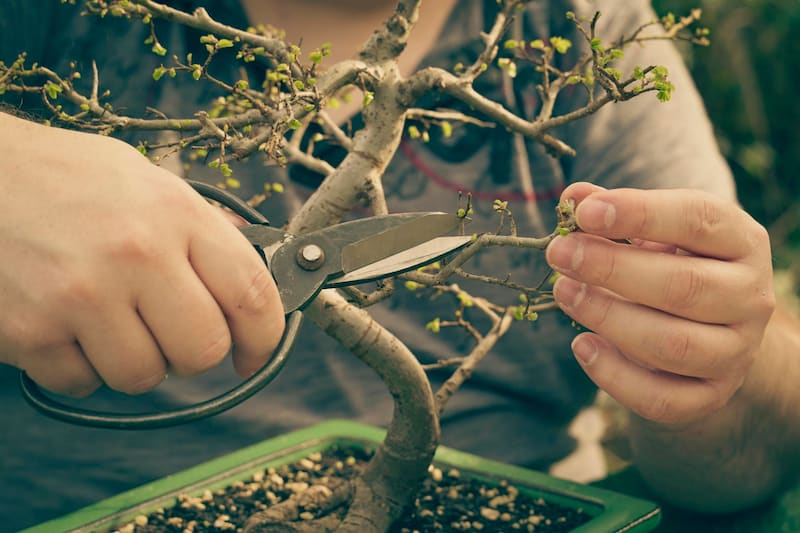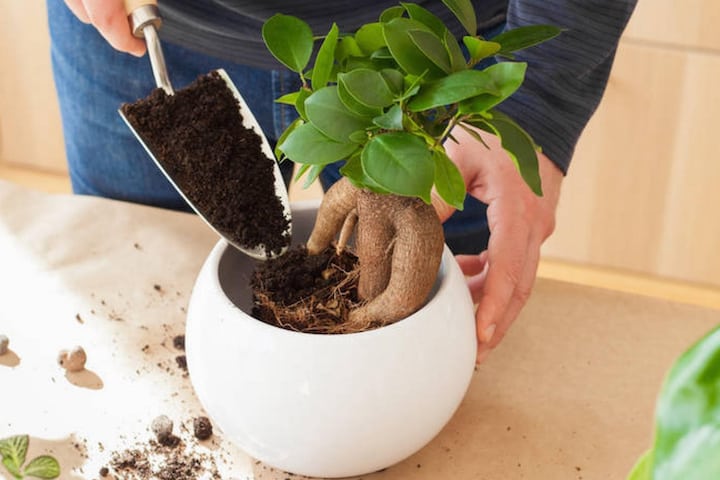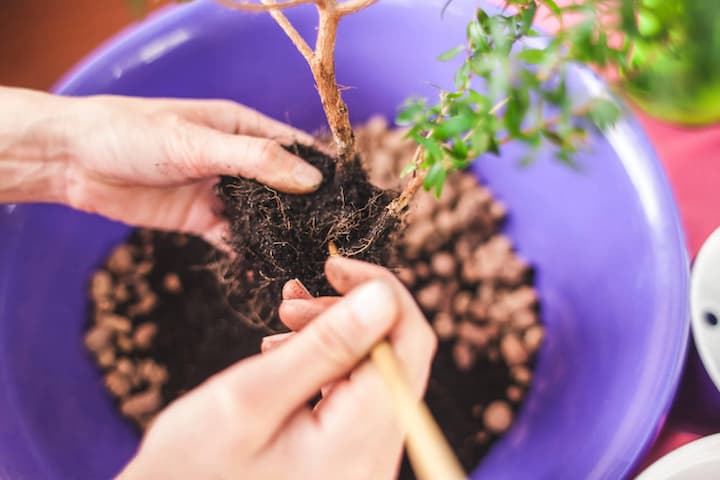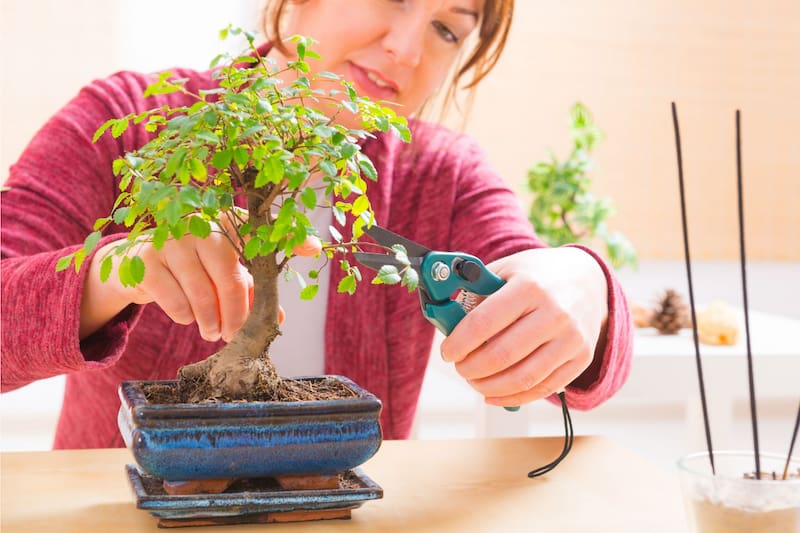Bonsai trees are beautiful, but they can also pose problems. If you’ve ever seen leaves falling off your bonsai tree, then you know that it’s time to get some help.
The main reasons for bonsai leaves to fall off include poor soil conditions, overwatering, insufficient light, nutrient deficiencies, pests, diseases, and improper pruning. With good bonsai tree care, you can prevent leaves from falling off.
This article will cover the main causes for bonsai tree leaves falling off and various solutions to fix and prevent leaves from dropping.
Reasons for Bonsai Leaves Dropping Off
The most common cause of Bonsai leaves drooping off is improper care. If you don’t cut away dead branches, they’ll continue to grow and eventually form new ones. This can lead to a tangled mess of branches and foliage.

1. Overwatering Bonsai Trees
Watering your bonsai too much can cause root rot. This happens when you water your bonsai more than once every 2-4 days depending on where you live and the type of bonsai tree you have.
Overwatering will lead to root rot, which will cause your bonsai to lose its leaves. Root rot is caused by bacteria getting into the roots through excess moisture.
Another factor that can lead to overwatering is poor soil conditions. You need well-draining bonsai soil, so that excess water drains through and the roots can breathe.
Good quality soil will allow the bonsai roots to easily absorb nutrients from teh soil.
2. Underwatering Bonsai Trees
Bonsai need more water than most plants. Their roots grow into the soil, but their leaves stay above ground. Bonsai are usually kept indoors because they get too hot or cold. They need to be watered regularly.
Waterings will need to occur more often during the growing season in the spring and summer months. Plants need more water when temperatures rise.
Pots should be placed in areas with high humidity. To avoid drying out, water bonsai trees regularly whenever you notice the soil is dry.
3. Insufficient Light
Indoor bonsais will inevitably receive less sunlight than outdoor bonsai. Their leaves drop because they don’t receive enough sunlight. Pruning removes the leaves and branches, but they won’t grow back without proper photosynthesis that results from enough light.
Indoor bonsai trees should be placed in a sunny window or you’ll see leaves dropping. Some indoor plants can’t tolerate extreme weather conditions and changes, so be careful with putting them by drafty windows, heating vents, and air conditioners.
4. Improper Bonsai Pot Drainage
Drainage holes in pots are essential for keeping soil moist, but not soggy. The drainage hole allows excess water to drain away from the pot. It prevents soil from becoming soggy.
You want to make sure that the drainage hole isn’t blocked up, leading to excess water not being able to escape, leading to root rot.
If water isn’t leaving the pot or it’s draining too quickly, the bonsai could also be rootbound, which means the roots aren’t receiving adequate oxygen. Roots are ‘bound’ because the roots have grown too large for its current pot. When they’re rootbound, they stop absorbing nutrients and water, and begin to decay.
5. Overfeeding or Underfeeding Bonsai Trees
Plant food is essential for the healthy growth of bonsai trees. You should use both liquid and solid fertilizers depending on the needs of the bonsai tree species you have.
If there is an absence of nutrients in the soil, the leaves will turn yellowish-brown, and the shoots will not grow properly. Underfeeding will eventually lead to leaves falling off. Eventually, your bonsai tree will be unable to fight off diseases.
Osmosis usually happens in plants in which water travels from roots to leaves. If you overfeed your tree too much, plasmolysis occurs, in which fluids start to move in the opposite direction, instead of through the cell walls. Because of plasmolysis (the breakdown of chlorophyll), the leaves will become dull and start to fall off.
Bonsai require feeding roughly every month during growth season. They need fertilizers containing nitrogen, phosphorus, potassium (NPK, respectively). Organic fertilizer contains more nutrients than chemical fertilizer. Switching to a low-nitrogen feed during refinement is important.
6. Pests and Disease
If your bonsai trees continue to lose leaves even after following proper care tips, it could be due to a pest infestation or disease. The most common diseases include root rot, rust, black spot, fungal infections like damping, galled, powdery mildew, and others.
Pests are also a cause of leaves falling off of bonsai trees. The most common pests damaging these plants are scale insects, Spider mites, aphids, vine weevils, root aphids, and adelgids.
7. Recent Bonsai Repotting
After repotting, bonsais lose some leaves due to the stress from repotting and moving to a new home. However, if the new soil is good quality, the leaves will grow again. Follow these general care tips after repotting to help reduce the stress.
It’s best to repot in the early spring in the beginning of the growing season when the weather is starting to warm up for what most bonsai tree species like. They like a temperature range between 55° to 65°F.
After repotting, keep the soil slightly wet until the roots have established themselves. Watering too soon will kill the new roots. Wait at least two weeks before watering. Afterward, water once a week until the soil dries out completely.
For fertilizer, wait 3-4 weeks before feeding. This gives the bonsai enough time to establish itself in its new environment.

Solutions to Stop Bonsai Leaves Dropping
1. Improve Sunlight Exposure
Bonsai trees need good sunlight exposure to grow properly. You can improve the amount of sunlight by placing them near windows or using artificial lighting.
How much light depends on the light requirements for the tree species that you chose. Putting bonsai pots on windowsills can give them plenty of light. Change the bonsai location to a south-facing window if you have one available.
Getting grow lights will help increase the amount of light available to the bonsai if you don’t have many windows.
2. Water Your Bonsai Properly
One of the best ways to prevent bonsai from dropping leaves is to keep it hydrated. Be careful of underwatering and overwatering the bonsai tree.
Underwatering means leaving the soil dry but keeping the pot filled with water. Overwatered bonsai will get soggy soil. It doesn’t matter how much water they’re getting as long as they’re not drowning.
When the top inch of the soil is dry, that’s an indication to water. Wait for the soil to dry before watering again.
3. Improve Soil Quality
Bonsai trees like well-draining bonsai soil. If your soil drains poorly, you may want to consider adding peat moss to your soil mix. Peat moss helps retain moisture and prevents the soil from drying out.
You should add peat moss to your bonsai soil mix only if you live in a humid area. Otherwise, you’ll risk having the bonsai tree develop fungus and rot.
Learn more about Bonsai Soil Mixes.

4. Balanced Fertilization
Over-fertilizing your bonsai is bad because it causes leaves to drop off. Feeding your bonsai properly promotes osmosis, in order to make sure that water and nutrients move into the root system. This helps the plant grow healthy and well.
Organic and synthetic fertilizer can be applied directly to the soil or root system of your bonsai. Liquid fertilizer is best diluted before being applied. A bonsai can be fed every two weeks during the growing season.
One disadvantage of synthetic fertilizers is that it will kill soil bacteria and mycorrhizal fungi. Organic fertilizer are slow release, so it’s less likely to overfeed with an organic fertilizer.
You should fertilize your plants once or twice a month during the growing season. Use an organic fertilizer with balanced nutrients. There’s no need to fertilize your plants in the winter during its dormancy period.
Lear more about Bonsai Fertilizers.
5. Disease and Pest Control
Diseases can cause leaves to fall off. They include bacterial wilt, powdery mildew, black spot, leaf scorch, and other diseases. Some pests such as aphids also cause leaves to drop off.
Here are common diseases and pests that you want to watch out for, and ways to treat and prevent them.
Leaf spot disease causes small brown spots on leaves. This disease can be treated by removing the infected leaves and using a solution for treatment.
Powdery mildew is a disease that causes leaves to turn yellow or brown. It is caused by molds that grow on plants. You should apply an anti-mildews agent to prevent this problem.
Sooty mold is caused by insects that eat plants. Insecticide treatments are used to control rust and black spot diseases.
Root rot is caused by poor drainage and when the roots are root bound. Roots look tangled and messy. This prevents proper drainage.
Rust and black spot causes yellowing of leaves and early leaf drop. Root care and proper drainage prevent these problems.
Aphids feed on the fluids of plants and cause slow growth. In the case of infestation, you can knock them off by using a brush and applying insecticidal soap.
Spider mites will create white cow webs between the branches. spider mites. Get rid of them by using insecticides like Malathion.
Scale insects are usually seen at the bark and stalks of trees. They suck fluids out of trees. Use a pesticide to remove Scale insects.
Fungicides are used to treat fungal infections. Insecticides are used to control pests and insects.
Follow these general tips for indoor and outdoor bonsai trees.
Indoor Bonsai Tree Care Tips
Indoor bonsai trees need to be watered regularly and given enough sunlight. They also need proper soil conditions. When they do get sick or injured, they should be moved away from other plants to avoid spreading any diseases.
Bonsai trees are popular among people who want to grow plants indoors.

Outdoor Bonsai Tree Care Tips
Deciduous trees lose their leaves as part of the natural cycle of life. Evergreen trees do not shed their leaves. These trees are usually found in colder climates.
You should choose the right kind of bonsai according to the weather in your region. For example, if you live in a cold region, you should choose species that can withstand freezing temperatures. If you live in a warm region, you should choose trees that can survive hot summers.
Top reasons for bonsai dropping leaves after identifying if your bonsai tree is suited for indoors or outdoor, you can easily sort them out.
Bonsai Dropping Leaves in Winter
Bonsai trees drop their leaves in the winter, but don’t worry, it’s completely normal. This is because they need to conserve water during this time. Shedding their leaves help keep them healthy and strong during its dormancy period.
In addition, some species have thicker foliage during winter than others. The reason why some trees drop their leaves while others don’t is due to genetics. Some species produce thick foliage all year round, so they never need to shed their leaves.
Other species only produce thin foliage in the spring and fall. Therefore, they need to shed their leaves to make room for new growth.
Overwintering is the process whereby a tree sheds its leaves before the first frost to survive the winter. It helps protect against damage from frosts and extreme cold. Overwintering occurs naturally every year. However, many species over-winter better than others.
Bonsai trees need to be protected from cold weather. When the temperature drops below freezing, trees might freeze. This means they stop growing and start storing energy.
If you can keep it in a greenhouse or shed, it’s best because even just a few degrees warmer will help. Frost cloths can help protect them from freezing weather.
Learn more in the in-depth article on How to Protect Bonsai Trees in Winter.
Bonsai Dropping Leaves in Summer
When it gets very hot outside, bonsai trees may struggle to cope with the heat. Their leaves may wilt and droop. In fact, they may even start to dry up.
This makes the leaves feel heavy and causes them to wilt. You can prevent this by watering your bonsai regularly.
The intense direct sunlight can cause the leaves to turn yellow and become brittle. To avoid this, you should move your bonsai into a shaded area. It will still get bright indirect light, but not the harshness of direct light.
Overfeeding your bonsai can lead to yellowing and dropping leaves. Always use fertilizer sparingly when feeding your bonsai. Too much fertilizer can burn the leaves.
Bonsai Leaves Turning Yellow and Falling Off
It’s important to know what causes your bonsai leaves to turn yellow and begin to fall off. There are several factors that can contribute to your bonsai turning yellow and falling off.
One factor is too much sun exposure. Your bonsai needs plenty of shade to stay green and healthy. On the other side, a lack of sunlight can also turn leaves yellow and fall off.
Overwatering and underwatering bonsais will cause them to turn yellow and lose their leaves. Proper bonsai watering is to water when you see the top 1-2 inches of soil dry. You can use your finger to test it by sticking your finger into the soil.
Pests and diseases can also cause your bonsai to turn yellow and lose its leaves. If you notice anything unusual on your bonsai, such as mold or insects, you can use insecticidal soap or neem oil to treat it.
Another common problem leading to yellow leaves that fall off is a nutrient deficiency or the opposite, over-fertilization. Nutrient imbalances are caused by improper fertilization. They can result in poor root development, stunted growth, and leaf discoloration.
Bonsai Leaves Turning Brown and Falling Off
The most common causes for bonsai leaves turning brown and falling off are overheating and overwatering. The leaves will look wilted and dry.
You can try spraying some water directly onto the leaves to revive them. Alternatively, you can mist your bonsai daily. Be sure to mist only the upper part of the plant and not add more water if the bonsai was already watered.
Over exposure to the sun causes bonsai tree leaves to turn brown and fall off. You will see signs of leaf scorch, which is when the leaves turn brown and curl at the edges.
Some tips to prevent this include placing your bonsai in a shady spot during the day. If you have no choice but to leave it out in full sun, cover it with a large umbrella or tent.
In addition, make sure your bonsai has enough water. Watering your bonsai every few days will help keep it hydrated and prevent it from drying out.
Overfeeding will also lead to brown leaves and fallen leaves. Try using a fertilizer that contains less nitrogen than potting mix. This will prevent your bonsai from getting too many nutrients.
Root rot and other root damage can also cause bonsai leaves to be brown and lose its leaves. Make sure you check your bonsai regularly and remove any dead or damaged roots when you notice any falling brown leaves.
Will Bonsai Leaves Grow Back?
Yes, bonsai leaves will grow back with proper care. The keys to regrowth are consistent feeding, regular watering, and good air circulation. Make you have well-draining soil, so excess water doesn’t lead to root rot or other root issues.
Feed your bonsai once a week. Use a fertilizer that is low in nitrogen and high in phosphorus and potassium. Avoid fertilizers containing copper and zinc because they can burn the foliage.
Water your bonsai thoroughly. It’s important to water deeply and evenly around the base of the trunk. Don’t let the soil become soggy though. Instead, water until the top inch of soil is completely saturated.
Bonsai recovery needs plenty of sunlight. Place your bonsai in an area where it receives plenty of bright indirect sunlight for several hours each day. Keep it away from drafts and cold winds.
Keep your bonsai healthy and those bonsai leaves will grow back.
Bonsai Leaves Falling Off Final Thoughts
It’s very easy to get started on your own bonsai and prevent bonsai leaves from dropping off. All you need is a little bit of time and patience for healthy bonsai plants.
For more bonsai tree articles, check these out:


